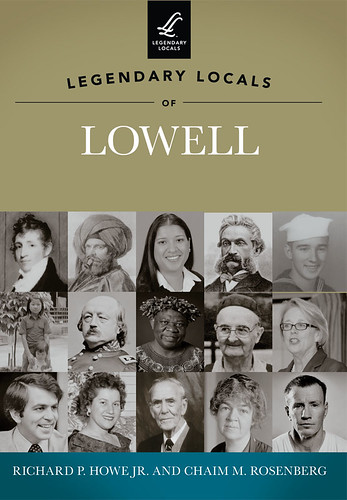Legendary Locals of Lowell

March 11, 2013 is the publication date of my first book, Legendary Locals of Lowell. The book is part of a new series from Arcadia Publishing called “Legendary Locals” which is described on the Arcadia website as follows: “Each book in Arcadia Publishing’s Legendary Locals imprint delves into the history of some of the unique individuals and groups, past and present, who have had a lasting impact on their community throughout its history.”
I first met my co-author, Chaim “Mike” Rosenberg, at a talk he gave on his newly published “The Life and Times of Francis Cabot Lowell, 1775-1817” at the Needham Public Library almost two years ago. From there we struck up a friendship with him taking me on a tour of the original Boston Associates mill in Waltham and me giving him a tour of Lowell Cemetery. Mike had already done two other books for Arcadia and invited me to collaborate with him on another about the mills of Lowell. We submitted our proposal to Arcadia but they had just launched the Legendary Locals series and wanted one about Lowell. Soon there was an agreement and Legendary Locals of Lowell was the result.
Here’s the back cover text from the book:
When Nathan Appleton and his colleagues built their first textile mill on the banks of the Merrimack River in 1822, they were pursuing the vision of their departed mentor, Francis Cabot Lowell. The complex system of machinery, labor, management and capital that resulted made the city that they named Lowell the centerpiece of the Industrial Revolution in America. Changes in technology and commerce made the golden age of Lowell’s mills short lived. Despite the success of businesses such as the patent medicine company of James C. Ayer, jobs remained scarce for decades. Hard times created strong leaders, people like Congresswoman Edith Nourse Rogers, who sponsored the G.I. Bill, and writer Jack Kerouac, who added a new voice to the country’s literary mix. More recently, Paul Tsongas inspired a new generation to transform Lowell into one of the most exciting mid-sized cities in post-industrial America and a world model of urban revitalization. This book tells the city’s story through pictures of its people.
The book is organized in five chapters. Mills covers the rise of the Lowell mills, their golden era, their demise and their reinvention. Business is about the industries that tried to fill the gap left by the departure of the mills such as patent medicine, printing and munitions. Community covers family, school, church and recreation. Service highlights those who served our country in the military and our community in many capacities. Culture is about those who through their words, paintings and music have made the city the interesting, distinctive place it is today.
The book is available for pre-order on Amazon and will be sold locally at stores such as Guy Lefebvre’s Lowell Gallery. There also will be public readings and booksignings which we’ll announce and promote on this site. I have created a permanent “Legendary Locals of Lowell” page which you can view HERE and which will always be accessible by clicking the “Legendary Locals of Lowell” tab at the very top right of your computer screen.
What a great idea! I recognize several people on the cover one of them Medal of Honor recipient David McNerney who Ihad the pleasure of meeting. He was a true American Hero and a real gentleman. The City of Lowell needs to do something to honor David McNerney who grew up on Wilder Street.
I am so proud to see my grandfather, Camille J. Eno on the cover! He was truly a legendary Lowell character who could captivate any age audience with his memories and stories of working in the Lowell Boot Mills. As I girl I listened endlessly, and not always by choice, to the stories of his childhood and how he knew Betty Davis. I am so happy to see that his memory will be honored forever now. Thank you.
Thanks for the comments.
David, thanks especially for your words about David McNerney. Both he and his father, Edward, who was a decorated veteran of World War One, are featured in the book.
And Christine, thanks to the support of your relatives, there are two other Eno family photos in the book.
There is a plaque in his honor in The Hall of Flags at the Lowell Memorial Auditorium. His plaque is with the other Medal of Honor recipients with Lowell connections.
Dick, can you tell us who the gentleman with the turban is or do we have to wait until the book comes out? :)
Thanks for your efforts in documenting Lowell’s unique personalities.
Dick Eno
The man with the turban is John Lowell Jr., the son of Francis Cabot Lowell who was our city’s namesake. John was intimately involved in the operation of the mills and lived on Andover Street until his wife and two daughters died in a scarlet fever epidemic. Distraught, he set out to travel the world. This painting is from his time in Egypt. The inside the book version of this picture and the full caption tell more of the story.